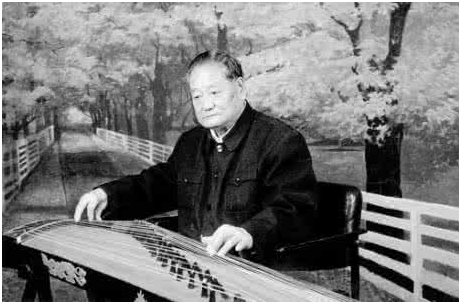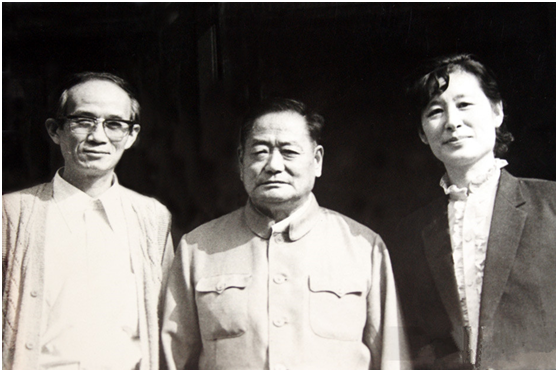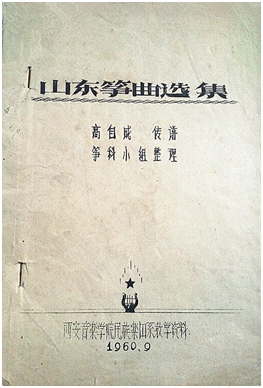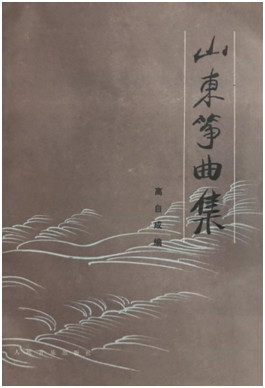Shandong Zheng·Gao Zicheng and "Autumn Moon in Han Palace"
Henan zheng and Chaozhou zheng, represented by Cao Dongfu and Guo Ying, entered the national instrumental music teaching system established by the Central Conservatory of Music and Shanghai Conservatory of Music respectively in the middle of the 20th century. The professional system teaching and inheritance under the environment, since then, professional music colleges have been established in various places, and guzheng has also been listed as one of the regular professional settings of the folk music department. In this issue, Gao Zicheng (1918-2010), a famous representative of the Shandong zheng school, is one of the pioneers of guzheng teaching in Northwest China. The zheng music part in "Baban".

Gao Zicheng, a famous master of the zheng school in Shandong
At the beginning of the 20th century, Shandong zheng was attached to the playing and singing activities of "Shandong Qinshu", a folk rap art of "Shandong Qinshu", which is a qupai style of sitting and singing: "It usually starts with playing and singing Shandong Qinshu. Recalling My Guzheng Artistic Career", published in Qin Zheng, 1983.6, Issues 2 and 3); in addition, when singing or sparring between musicians, they often ensemble a set of pure instrumental big boards, that is, "touch the eight boards" (also The form of string and cable ensemble called "Conversing Flowing Water" and "Duanbaban"), but often "when the ensemble of pure instrumental Daban suites, only some music lovers are left, but at this time it is the artists. It is a good opportunity for them to learn from each other and learn skills" (see Gao Zicheng's "Recalling My Guzheng Art Career"). Gao Zicheng's grandfather and uncle were both famous zheng players in Yuncheng. As a way of earning a living, Gao Zicheng learned to play zheng, dulcimer, and qin book with his grandfather and uncle since he was a child. The organized "Donglu Ya Music Club" went to various places to participate in performances and was famous for being good at playing the zither.
The commonly used musical instruments for the "touching the eight boards" in the string and cable ensemble are zheng, pipa, dulcimer and huqin. "Touching the Baban" refers to the simultaneous performance of the main accompaniment instruments in Shandong Qinshu, different pieces of music evolved from the same parent - the instrumental music card [Baban], which makes one aspect of the melody framework, phrase fall, music length and On the other hand, in each clause of [Baban], gradual clutches with different distances between voices are formed, and weaving a texture with superimposed acoustic polyphonic factors, showing The unique auditory aesthetics of seeking common ground while reserving differences between voices. Different musical instruments in the high, mid and low range, the point-like granularity and linear extension of the sound quality, the thickness difference of each other's sound, the clear collision of the same musical sound potential, sometimes go hand in hand under the control of the melody, sometimes in the In the transformation of the texture, the spread and diffusion, the fun of dividing and combining, and the playfulness of fingertip dialogue, reflect the vitality of "touching the eight boards" through the layers and diversity of sounds. From the main accompaniment instruments of Shandong Qinshu to the gradually stable "touching the eight boards" ensemble instruments, compared with the accompaniment of Qinshu that is attached to the plot and the development of singing, the string and cable ensemble that breaks away from the lyrics and enters the field of pure instrumental music is often a folk ensemble. It is an important place for musicians to further develop the strengths of musical instruments. The mutual matching of instrumental sounds, the interweaving of melody and tones, and the adjustment of the size of the rhythm and rhythm, etc., are often found in the dialogue and mutual listening of three or five combinations of musical instruments. Dig deeper for instrumental ensemble or even solo performance.

Group photo of Zheng artists Zhou Yanjia, Gao Zicheng and Qu Yun (from left to right) of Xi'an Conservatory of Music
In 1957, Gao Zicheng, known as "the first zheng master in the Great Northwest", went to the Northwest and took root there, becoming the first full-time guzheng teacher of Xi'an Conservatory of Music (the predecessor of Xi'an Conservatory of Music). Higher music institutes have begun to have a guzheng major” (see Zhou Yanjia, “The First Master of Zheng in Northwest China: Remembering the Anniversary of the Death of Professor Gao Zicheng”, published in Symphony, Issue 4, 2011). "In 1960, in order to welcome the National Guzheng Textbook Compilation Symposium held in Xi'an, the Department of Folk Music established a 'Zheng Section Group' to actively compile teaching materials. In notation, I often stayed up late at night. Teacher Gao played it again and again. Zhou Yanjia repeatedly pondered the notation, trying to be correct and true. Teacher Gao nodded and approved each piece of music. A total of 12 pieces of Xiaoban and 20 pieces of tunes in Qinshu were recorded. , 11 pieces on the big board, and finally mimeographed into a volume of "Shandong Guzheng Song Collection" (see Zhou Yanjia's "The First Master of the Great Northwest Zheng Master - Remembering the Death Anniversary of Professor Gao Zicheng"). In 1986, the "Shandong Zheng Song Collection" published by the People's Music Publishing House was further enriched on the basis of the original collection, and added two parts: Luyu Daban Cover and Creation and Compilation of Zheng Songs.

Gao Zicheng's biography "Shandong Zheng Song Collection" (1960 mimeograph)

Gao Zicheng edited "Shandong Zheng Song Collection" (People's Music Publishing House in 1986)
"Autumn Moon in the Han Palace" is one of the traditional representative pieces of the Shandong Zheng School. It describes the sadness of the ancient palace maids for the moon and the missing relatives. , so it is also marked as "big board first". Under the framework of the sixty-eight-ban ("eight-board") structure and the melody of "workmanship and four feet", the music uses the unique playing techniques of the right hand of Shandong zheng, such as splitting, picking and wiping. The big finger is split to set off the crisp and neat sound of the "tick" in the second half of the sixteenth note of the eye position. It can be said that the grasp of the board eye and size is reflected in the timing of each sound and the end of the sentence. strengthen. The unhurried flower finger, the accelerated crescendo of double tones, the leisurely vibrato, the ticklish press glide and the back glide that matches the Shandong dialect, make the connection between sounds and sounds unexpectedly show The rhyme of Shandong Zheng has a long meaning.
Involving the artist
Involving musical instruments
Guess you like
Hot news
- 01 The Simple Difference Between Guqin, Se, and Guzheng
- 02 The difference between the five-stringed lute and the four-stringed lute
- 03 The difference between cymbals and cymbals in ethnic musical instruments
- 04 Dulcimer exam and performance repertoire
- 05 The handsome guy in 1997 is so advanced in pulling erhu! Netizen: Come and "wash your ears"
 渝公网安备 50010702504639号
渝公网安备 50010702504639号